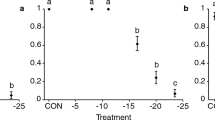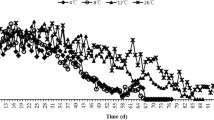Abstract
The effect of low temperature acclimation and diet on the supercooling point (SCP, the temperature at which the insect’s body fluids freeze) and lethal time (LTime, time required to kill 50 % of the population at a temperature of 5 °C) of the mealybug destroyer, Cryptolaemus montrouzieri Mulsant (Coleoptera: Coccinellidae), was assessed in the laboratory. The SCP of acclimated adult ladybirds which were allowed to complete development to adulthood at 18 °C and a 8:16(L:D)h photoperiod, or at 25 °C and a 16:8(L:D)h photoperiod, and which were subsequently kept at 10 °C and a 12:12(L:D)h photoperiod for seven days, was −17.4 and −16.8 °C, respectively. These SCP-values were approximately 7 °C lower than the value of −9.9 °C for non-acclimated ladybirds maintained at a temperature of 25 °C and a photoperiod of 16:8(L:D)h throughout development and in the first week of their adult life. Also food source had a significant effect on the freezing temperature of C. montrouzieri: the SCP of ladybirds fed the citrus mealybug, Planococcus citri (Risso)(Hemiptera: Pseudococcidae), was 1.6 °C higher than the value of −17.2 °C observed for ladybirds provided with eggs of the flour moth Ephestia kuehniella Zeller (Lepidoptera: Pyralidae). However, neither cold acclimation nor diet had a significant effect on the lethal times of C. montrouzieri. Overall, the time required to kill 50 % of the population at a temperature of 5 °C ranged from 12.8 days for ladybirds fed P. citri mealybugs to 14.4 days for ladybirds fed E. kuehniella eggs. All individuals exposed to a constant 5 °C had died by day 24. Based on the results from this laboratory study, it is deemed unlikely that C. montrouzieri could establish outdoors in western Europe, and it is therefore expected to pose little risk to non-target species in this area when used as an augmentative biological control agent.

Similar content being viewed by others
References
Babu TR, Azam KM (1987) Biology of Cryptolaemus montrouzieri Mulsant (Coccinellidae, Coleoptera) in relation with temperature. Entomophaga 32:381–386
Bale JS (2011) Regulation of invertebrate biological control agents in Europe: recommendations for a harmonised approach. In: Ehlers RU (ed) Regulation of biological control agents. Springer Science and Business Media B.V, The Netherlands, pp 323–374
Bale JS, Allen CM, Hughes GE (2009) Thermal ecology of invertebrate biological control agents: establishment and activity. In: Third international symposium on biological control of arthropods (ISBCA) Christchurch, New Zealand, 8–13 Feb 2009, pp 56–65
Bartlett BR (1974) Introduction into California of cold-tolerant biotypes of the mealybug predator Cryptolaemus montrouzieri, and laboratory procedures for testing natural enemies for cold-hardiness. Environ Entomol 3:553–556
Berkvens N, Bale JS, Berkvens D, Tirry L, De Clercq P (2010) Cold tolerance of the harlequin ladybird Harmonia axyridis in Europe. J Insect Physiol 56:438–444
Block W (1990) Cold tolerance of insects and other arthropods. Phil Trans R Soc B 326:613–633
Booth RG, Pope RD (1986) A review of the genus Cryptolaemus (Coleoptera: Coccinellidae) with particular reference to the species resembling C. montrouzieri Mulsant. Bull Entomol Res 76:701–717
Chown SL, Terblanche JS (2006) Physiological diversity in insects: ecological and evolutionary contexts. Adv Insect Physiol 33:50–152
Clausen CP (1978) Introduced parasites and predators of arthropod pests and weeds: a world review. United States Department of Agriculture, Washington, USA, p 545
Constantine B, Majerus M (1994) Cryptolaemus montrouzieri, Mulsant (Col., Coccinellidae) in Britain. Entomol Mon Mag 130:45–46
Danks HV (2007) The elements of seasonal adaptations in insects. Can Entomol 139:1–44
DeBach P, Hagen KS (1964) Manipulation of entomophagous species. In: DeBach P, Schlinger EI (eds) Biological control of insect pests and weeds. Chapman and Hall, London, UK, pp 429–458
Ehlers RU (2011) Regulation of biological control agents. Springer, Dordrecht, The Netherlands, p 416
Ehnström B, Lundberg S (1997) Cryptolaemus montrouzieri, en nyckelpiga som användas för biologisk bekämpning i växthus i Sverige. Entomol Tidskr 118:59–60
Finlay-Doney M, Walter GH (2012) The conceptual and practical implications of interpreting diet breath mechanistically in generalist predatory insects. Biol J Linn Soc 107:737–763
Fisher TW (1963) Mass culture of Cryptolaemus and Leptomastix: natural enemies of the citrus mealybug. Bulletin California Agricultural Experiment Station No. 797
Funasaki GY, Lai PY, Nakahara LM, Beardsley JW, Ota AK (1988) A review of biological control introductions in Hawaii: 1890 to 1985. Proc Hawaiian Entomol Soc 28:105–160
Grenier S, De Clercq P (2003) Comparison of artificially vs. naturally reared natural enemies and their potential use in biological control. In: van Lenteren JC (ed) Quality control and the production of biological control agents: Theory and testing procedures. CABI Publishing, Wallingford, UK, pp 115–131
Halstead AJ (1999) Frost survival by Cryptolaemus montrouzieri Muls. (Coleoptera: Coccinellidae) in an outdoor situation. Br J Entomol Nat Hist 11:163–164
Hansen LO, Sagvolden BA (2007) Notes on Norwegian Coleoptera 6. Norw J Entomol 54:75–80
Hanson AA, Venette RC, Lelito JP (2013) Cold tolerance of Chinese emerald ash borer parasitoids: Spathius agrili Yang (Hymenoptera: Braconidae), Tetrastichus planipennisi Yang (Hymenoptera: Eulophidae), and Oobius agrili Zhang and Huang (Hymenoptera: Encyrtidae). Biol Control 67:516–529
Hart AJ, Tullett AG, Bale JS, Walters KFA (2002a) Effects of temperature on the establishment potential in the U.K. of the non-native glasshouse biocontrol agent Macrolophus caliginosus. Physiol Entomol 27:112–123
Hart AJ, Bale JS, Tullett AG, Worland MR, Walters KFA (2002b) Effects of temperature on the establishment potential of the predatory mite Amblyseius californicus McGregor (Acari: Phytoseiidae) in the UK. J Insect Physiol 48:593–599
Hatherly IS, Bale JS, Walters KFA, Worland MR (2004) Thermal biology of Typhlodromips montdorensis: implications of its introduction as a glasshouse biological control agent in the UK. Entomol Exp Appl 111:97–109
Hatherly IS, Hart AJ, Tullett AG, Bale JS (2005) Use of thermal data as a screen for the establishment potential of non-native biological control agents in the UK. BioControl 50:687–698
Hatherly IS, Pedersen BP, Bale JS (2008) Establishment potential of the predatory mirid Dicyphus hesperus in northern Europe. BioControl 53:589–601
Hughes GE, Bale JS, Sterk G (2009) Thermal biology and establishment potential in temperate climates of the predatory mirid Nesidiocoris tenuis. BioControl 54:785–795
Inc SPSS (2009) Guide to data analysis. SPSS Inc, Chicago, USA
Iperti G (1999) Biodiversity of predaceous coccinellidae in relation to bioindication and economic importance. Agric Ecosyst Environ 74:323–342
Kairo MTK, Paraiso O, Gautam RD, Peterkin DD (2012) Cryptolaemus montrouzieri (Mulsant) (Coccinellidae: Scymninae): a review of biology, ecology, and use in biological control with particular reference to potential impact on non-target organisms. CAB Rev 8:1–20
Maes S, Machtelinckx T, Moens M, Grégoire JC, De Clercq P (2012) The influence of acclimation, endosymbionts and diet on the supercooling capacity of the predatory bug Macrolophus pygmaeus. BioControl 57:643–651
Maes S, Antoons T, Grégoire JC, De Clercq P (2014a) A semi-artificial rearing system for the specialist predatory ladybird Cryptolaemus montrouzieri. BioControl 59:557–564
Maes S, Grégoire JC, De Clercq P (2014b) Prey range of the predatory ladybird Cryptolaemus montrouzieri. BioControl. doi:10.1007/s10526-014-9608-5
Malais MH, Ravensberg WJ (2002) Kennen en herkennen: levenswijzen van kasplagen en hun natuurlijke vijanden. Reed Business Information, Doetinchem, The Netherlands
McCullagh P, Nelder J (1989) Generalized linear models. Chapman and Hall, London, UK, p 532
Moreau C (2005) Une lutte dans les hauteurs. Le Soir June 6, 2005, pp 17–18
Roy H, Migeon A (2010) Ladybeetles (Coccinellidae). In: Roques A, Kenis M, Lees D, Lopez-Vaamonde C, Rabitsch W, Rasplus J-Y, Roy D (eds) Alien terrestrial arthropods of Europe. BioRisk 4:293–313
Ślipiński SA (2007) Australian ladybird beetles (Coleoptera: Coccinellidae): their biology and classification. Australian Biological Resources Study, Canberra, Australia, p 288
Sømme L (1982) Supercooling and winter survival in terrestrial arthropods. Comp Biochem Physiol A 73:519–543
Specty O, Febvay G, Grenier S, Delobel B, Piotte C, Pageaux J-F, Ferran A, Guillaud J (2003) Nutritional plasticity of the predatory ladybeetle Harmonia axyridis (Coleoptera: Coccinellidae): comparison between natural and substitution prey. Arch Insect Biochem Physiol 52:81–91
Tullett AG, Hart AJ, Worland MR, Bale JS (2004) Assessing the effects of low temperature on the establishment potential in Britain of the non-native biological control agent Eretmocerus eremicus. Physiol Entomol 29:363–371
van Lenteren JC, Babendreier D, Bigler F, Burgio G, Hokkanen HMT, Kuske S, Loomans AJM, Menzler-Hokkanen I, van Rijn PCJ, Thomas MB, Tommasini MG, Zeng QQ (2003) Environmental risk assessment of exotic natural enemies used in inundative biological control. BioControl 48:3–38
van Lenteren JC, Bale J, Bigler F, Hokkanen HMT, Loomans AJM (2006) Assessing risks of releasing exotic biological control agents of arthropod pests. Annu Rev Entomol 51:609–634
Acknowledgments
This research was supported by BOF (UGent).
Author information
Authors and Affiliations
Corresponding author
Additional information
Handling Editor: Ralf Ehlers.
Rights and permissions
About this article
Cite this article
Maes, S., Grégoire, JC. & De Clercq, P. Cold tolerance of the predatory ladybird Cryptolaemus montrouzieri . BioControl 60, 199–207 (2015). https://doi.org/10.1007/s10526-014-9630-7
Received:
Accepted:
Published:
Issue Date:
DOI: https://doi.org/10.1007/s10526-014-9630-7




